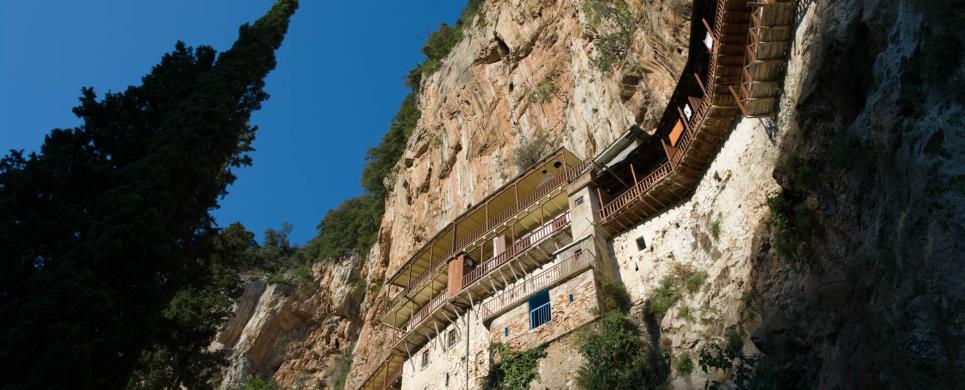Listed 23 sub titles with search on: Culture & Art Centres for wider area of: "PELOPONNISOS Region GREECE" .
KALAMATA (Town) MESSINIA
Tel: +30 27210 22607
Fax: +30 27210 22907

MONI AGIOU IOANOU PRODROMOU (Monastery) STEMNITSA
Tel: +30 27950 81385, 81447
MONI GORGOEPIKOOU (Monastery) MANTINIA
Tel: +30 2710 561209
MONI VARSON (Monastery) KORYTHIO
Tel: +30 2710 572302
VYTINA (Village) ARCADIA
Tel: +30 27950 22017
Fax: +30 27950 22017

CHORA (Small town) MESSINIA
Chora is close to the archaeological site of Eglianos, where the kingdom of the homeric king Nestoras was. In this museum, which is one of the most important provincial museums of Greece and an «ornament» for the city, archaeogical findings from various historical eras are exhibited. In the three rooms of the museum, there are about 4000 findings from the excavations of Carl Blegen, Spyros Marinatos and lately of professor George Korre, in the areas of Pylia and Trifylia (Peristeria) which belong to the Mesohellenic (2200 - 1580 B.C) and the Late Hellenicc(Mycaenean) Era (1580-1120 B.C).
This text is cited Jan 2003 from the Messenia Prefecture Tourism Promotion Commission URL below, which contains image.
ERMIONI (Small town) ARGOLIS
Adjacent to the church of Agioi Taxiarchoi is situated a restored
house built in the local vernacular style, the Economou Residence, where the Third
National Assembly began in 1827. Today, the building houses the town’s museum
of history and folklore. In the front garden stand the statues of the Mitsa brothers,
leaders of the Greek War of Independence in Ermioni.
In the vicinity of the museum is situated an old school dating back
to the time of Kapodistrias; constructed on an ancient wall, the school currently
serves as a center for cultural events.
This text (extract) is cited March 2004 from the Municipality
of Ermioni tourist pamphlet.
KORINTHOS (Town) PELOPONNISOS
The legal status of this museum is Legal Persona of Private Law. It
was founded in 1976 and opened to the public in 1988. The purposes of this museum
are to collect and promote folk art items for the benefit of public education.
It is housed in own premises, a three-storeyed building designed by S. Kydoniatis.
Its collections include various silver handicraft, woodwork, farm implements and
utilities resourced from the area of Corinth. Other items include: costumes and
their paraphernalia from all regions of the country, embroidered fabrics and rare
publications. This museum participates in and organizes training programmes and
temporary exhibitions.
This text is cited May 2003 from the Hellenic Ministry of Foreign Affairs URL below.
LYKOSSOURA (Village) MEGALOPOLI



MYSTRAS (Village) PELOPONNISOS
This museum was inaugurated in 1951 and housed in a two-storeyed building
located in the northern section of the Cathedral of Agios Demetrios. It hosts
a significant number of collections incorporating sculpture, pottery, coins, church
icons, pieces of vestments, frescoes and various miniature works.
Among the items exhibited are:
•Two sections of the epistyle of the iconostasis from the Pantanassa Church
•Marble Proskynetarion with relief representation of Christ (15 c. A.D.)
•Parapets and epistyles of an iconostasis of the Kantakouzenos family.
•Post-Byzantine icon representing St. John Chrysostomos (by Th. Poulakis)
•The icon of Christ "the Vine of Life", a work by Victor
This text is cited May 2003 from the Hellenic Ministry of Foreign Affairs URL below.
NAFPLIO (Town) PELOPONNISOS

PYLOS (Small town) MESSINIA
The Museum of Pylos is a point of reference for all the monuments of the province. In two of its rooms one can find stored all the movable archaeological findings from the area of Voedokilia and other areas of Pylia from the Stone Age (7.000-3.000 B.C) to the Mycaenaic Era (2600-1120 B.C) and the Hellenistic years(336-31 B.C). There is also a variety of jewels from the Revolution of 1821.
This extract is cited Jan 2003 from the Messenia Prefecture Tourism Promotion Commission URL below, which contains image.
SPARTI (Town) LACONIA
The Museum of Ancient Sparta is the only museum built in Greece between
1874 and 1876 by architect G. Katsaros. The exhibits within the museum represent
only a small portion of the ruins found in excavations within the town of Sparta
and areas around it. One of the most important samples is part of the Temple of
goddess Artemis. The Temple was built back in 10th Century BC and survived during
most of the Roman era. The plethora of findings from the Temple reveals the great
number of vows to the goddess. Some of them are made out of ivory and stone, while
others are made of clay, like the clay masks (copies of wooden ones) used during
ceremonies in the Temple. There are also a large number of labeled columns with
built in metal scythes, commemorating the winners of contests dedicated to goddess
Artemis. In a different area within the museum, there are parts of the Temple
of Apollon in Amycles. The particular temple was designed in a unique way in order
to combine the worship of Doric Apollon and early Doric Hyacinth. The excavations
around the town of Sparta revealed parts of wealthy family ancient houses, like
the elaborate mosaic floors which are now on display in another section of the
museum. Two of the most famous floor samples depict the head of Achilles from
Skyros and the head of Gorgos. The Museum includes findings from areas beyond
Sparta, ranging from the pre-historic era to the Roman times. Some of the pre-historic
findings are located upstairs and originally come from all over Laconia (Melathra,
Epidauros, Amykles, Pellana) and Arcadia (Palaiokastro, Gortynia). Hopefully,
a newer and larger museum will be built soon and it will accommodate the majority
of the treasures of the ancient Laconia.
This text is cited Mar 2003 from the Laconian Professionals URL below, which contains images.





STEMNITSA (Village) TRIKOLONES








Receive our daily Newsletter with all the latest updates on the Greek Travel industry.
Subscribe now!